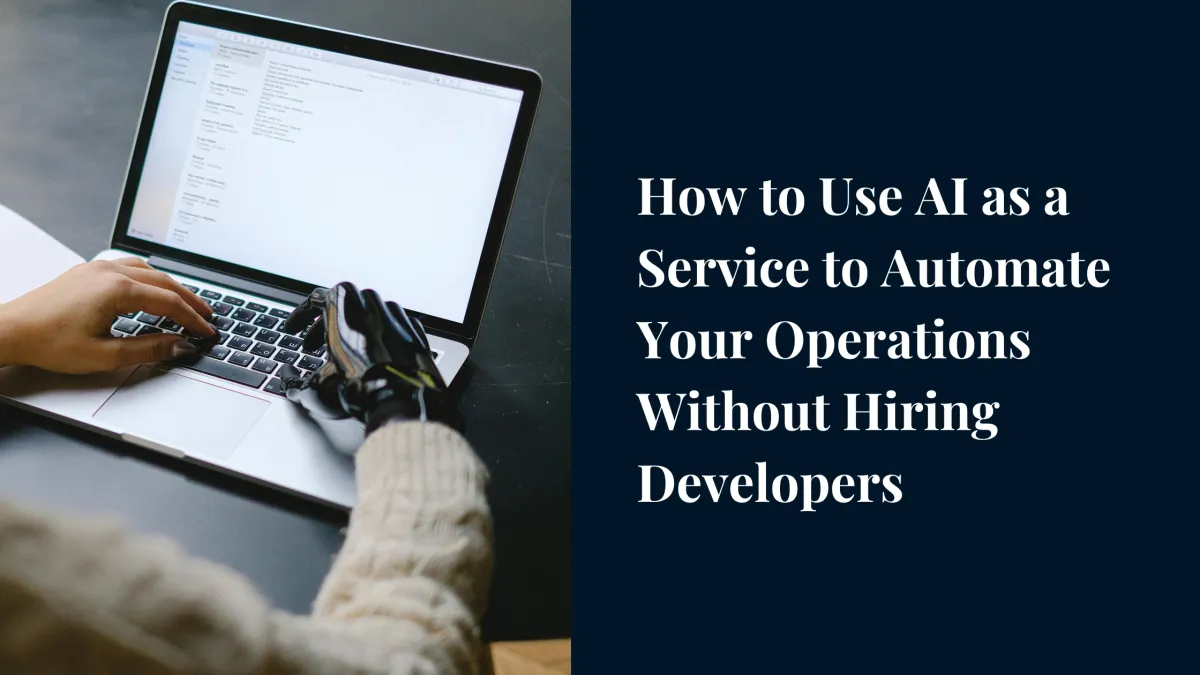
How to Use AI as a Service to Automate Operations Without Hiring Developers
For service-based business owners generating $1M–$20M annually, scaling operations can feel like spinning plates—HR, finance, marketing, and client services all demand attention. But what if you could eliminate the chaos, reclaim your time, and increase profitability without hiring a team of developers?
Enter AI as a service (AIaaS)—a game-changer for businesses looking to automate intelligently, fast, and affordably. In this blog post, we’ll show you how to harness AI as a service to automate your workflows, streamline your backend, and grow your business without a tech background or a massive dev budget.
Step 1: Understand What AI as a Service Actually Means
AI as a service refers to ready-to-use AI tools and platforms delivered through the cloud. You don’t need to build models from scratch or manage any infrastructure—vendors handle the tech, and you use the tools. Think of it like Netflix for automation: pay-as-you-go, flexible, and scalable.
Popular AIaaS platforms include:
ChatGPT or Claude for conversational automation
Zapier + OpenAI integrations for task automation
Google Cloud AI or AWS for enterprise-level use cases
Step 2: Identify Key Business Processes Ripe for Automation
Start by mapping out repetitive, time-consuming tasks across departments. These could include:
Client onboarding
Proposal generation
Data entry and report generation
Email follow-ups and customer support
Ask your team: “What task do you dread doing each week?” That’s usually a sign of a prime automation opportunity.
Tip: Focus first on processes with high volume and low variability.
Step 3: Choose the Right AIaaS Tools Based on Use Case
Once you know what you want to automate, choose tools based on function, not hype. A few examples:
Client communication automation: Use AI chatbots powered by ChatGPT or Tidio
Data handling: Leverage OCR + AI via platforms like Rossum or Microsoft AI Builder
Sales & CRM: Automate emails, lead scoring, and follow-ups using HubSpot AI tools or Apollo
The right AI as a service provider will offer no-code or low-code interfaces—so you don’t need a developer to build custom solutions.
Step 4: Set Up Automations with No-Code Platforms
Platforms like Zapier, Make (formerly Integromat), and Pipedream allow you to create intelligent automations using drag-and-drop interfaces. You can:
Connect your CRM to your invoicing system
Auto-generate reports when data hits your system
Use GPT-powered tools to write first drafts of client emails
Pro Tip: Start small. Automate one use case and measure the time saved.
Step 5: Test, Monitor, and Optimize
Even the best AI workflows need human supervision. Assign someone to:
Test edge cases (e.g., what happens when a chatbot doesn’t know an answer)
Monitor success rates (e.g., how often a workflow completes without manual input)
Improve outputs (e.g., tweak AI prompts for better client messages)
Want to automate the right way the first time? Book a consult to map out your AI strategy.
Additional Tips for Success
💡 Choose Tools with Good Support
AI tools evolve quickly. Work with vendors that offer active customer support, tutorials, and a user community.
⚠️ Avoid Automating Broken Processes
If a workflow is inefficient manually, automating it just accelerates the mess. Clean it up first, then automate.
🔐 Don’t Overlook Data Privacy
Make sure your AI services comply with your industry’s data regulations (HIPAA, GDPR, etc.). Choose AI providers with strong data security policies.
🧠 Don’t DIY Everything
While AI as a service removes the need for developers, having an automation strategy is key. That’s where consulting partners like Syntra Advisors come in—we help you connect the right tools to your unique workflows and revenue goals.
Conclusion: AI as a Service = Scalable, Smart Automation for Growing Businesses
You don’t need to hire an expensive development team or understand machine learning to start using AI in your business. With the rise of AI as a service, the path to streamlined operations and a scalable backend is more accessible than ever.
By identifying automation-ready workflows, choosing the right tools, and implementing with a lean, iterative approach, your business can:
Reclaim hours every week
Improve team efficiency
Scale profitably—with less stress